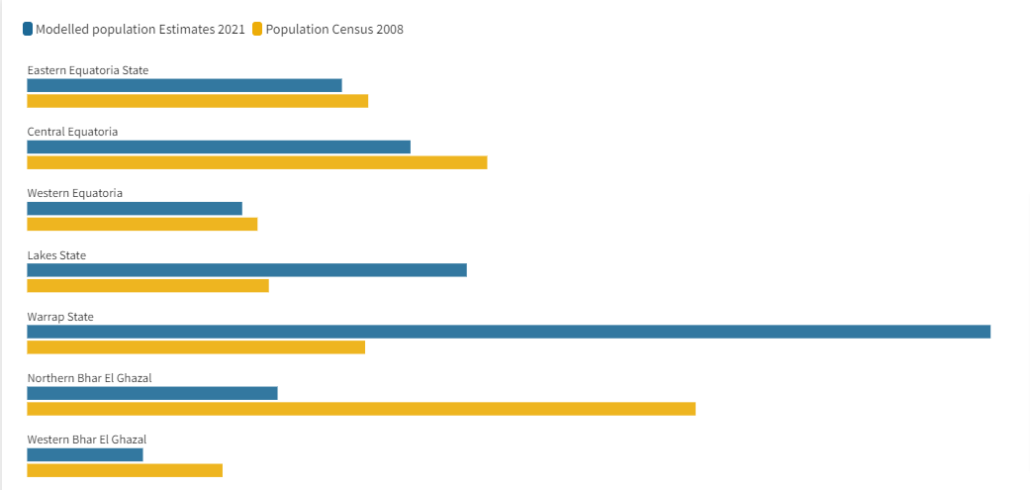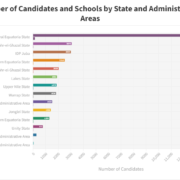Data Story: South Sudan’s population surges to 12.4 million, reveals 2021 survey
The survey is expected to be an essential resource for the government’s development planning, decision-making, and provision of services as it provides the latest accurate population estimates and other demographic and socio-economic characteristics of the inhabitants.
Writer: Jibi Moses
The National Bureau of Statistics (NBS) in South Sudan released the Population Estimation Survey 2021 (PES) on April 6th, 2023, revealing a surge in the country’s population to 12.4 million people, a rise of over four million people. The PES 2021 was conducted between May 28th and June 15th, 2021, across ten states and three Administrative areas, with a female population of 52.9% and a male population of 47.1%, while the youth population stands at 77%.
The PES 2021 is expected to be an essential resource for the government’s development planning, decision-making, and provision of services. The survey will monitor the performance of the National Development strategy and the sustainable development goals while providing policymakers with briefs and reference points for research.
With South Sudan’s last census conducted in 2008, the PES 2021 provides the latest accurate population estimates and other demographic and socio-economic characteristics of the inhabitants. The NBS utilised satellite imagery and enumeration to ensure the quality of information and data for the survey met the basic assumptions of the analytic method.
Despite the impact of civil war outbreaks since independence in 2011, the PES 2021 provides a comprehensive and up-to-date representation of South Sudan’s population, enabling policymakers and decision-makers to implement evidence-based planning and decision-making for progress and sustainable development in the country.
The country’s last Census was in 2008, when it was still an autonomous region of Sudan. While releasing the results, Isaiah Chol Aruai, the chairperson of NBS, explained that the figures are based on satellite imagery and enumeration across ten states and three Administrative areas.
“The quality of information and data for a given locale, as well as the ability of the data to meet the basic assumptions of the analytic method, are key to performing accurate estimates or projections,” Isaiah Chol Aruai said.
| S/No. | State/Administrative area | Modelled Population Estimates |
| 1 | Upper Nile | 790,147 |
| 2 | Jonglie | 791,105 |
| 3 | Unity | 892,780 |
| 4 | Western Bahr El Ghazal | 562,555 |
| 5 | Northern Bahr el Ghazal | 1,924,342 |
| 6 | Warrap | 2,639, 484 |
| 7 | Lakes | 1,265, 473 |
| 8 | Western Equatoria | 663,233 |
| 9 | Central Equatoria | 1,324,521 |
| 10 | Eastern Equatoria | 981,902 |
| 11 | Greater Pibor A A | 240,102 |
| 13 | Ruweng AA | 234,416 |
| 14 | Abyei | 133,955 |
| Total | 12,444,018 |
National statistical offices often produce estimates and projections of various characteristics of a population. These statistics are a vital source of information for decision-makers throughout the government, the private sector, and civil society. An estimate calculates a population’s size or distribution or another population characteristic for the present or past. At the same time, a projection describes these characteristics in the future.
In most countries, policymakers and other data users often require accurate information between census data releases every ten years. Although a full population count only occurs during a census, statistical methods and tools often produce regular, up-to-date population estimates.
Population estimates can describe the population size and demographic characteristics such as age, sex, or education level. Population estimates depend on change’s demographic components: mortality, fertility, and migration.
Estimates of mortality, fertility, and migration estimates are derived from data available from censuses, surveys, registration systems, and other administrative records. Estimates and projections are calculated similarly. However, estimates employ observed data and hypotheses of demographic change when data are incomplete. Projections, on the other hand, rely on hypotheses about demographic change in the future.
One of the most widely used approaches for producing population estimates and projections is the Cohort Component Method, which can be used to calculate detailed statistics such as population by age and sex, total fertility rate, infant mortality rate, and population growth rate. A population may also be estimated and projected for multiple geography units, from the national to various subnational levels (e.g.States, Counties, Districts, Payams, Bomas).



Criticisms from the Public:
The PES 2021 report was received with much scepticism and criticism from the public. Individuals and organisations criticised the authenticity of the data. Some voices challenging the report can be found in this article by The East African and an analysis by The Sudd Institute.
“Some opposition politicians and some in the civil society questioned the estimates that put the total of the country’s population to 12,444,018 and are demanding what they term “a proper census” as per the 2018 peace agreement. UN estimates had put the population at 11,556,069 even though the UN itself partly supported the current survey,” reports The East African
Augustino T. Mayai, the Managing Director of the Sudd Institute, an independent research organisation, analysed the scientific, political, and policy implications of the PES results stating that the new estimates are in stark contrast with South Sudan’s 2008 census counts, which stood at 8.26 million, informing the 2010 regional and national elections. These estimates, he says, “…have so far generated heated debates in various quarters, with many outright contesting them for a host of good reasons.”
However, on the 13th of April, NBS clarified that the PES 2021 results should not be used for electoral purposes, Juba Echo, but for planning and policy guidance, such as Something Augustino T. Magai questions.
‘’…if the PES results cannot be used for electoral purposes, then it is odd to use them
for development. Using the scientifically troubled PES results for development (i.e.,
distributing services) is more problematic than using them for politics. This is because
development is for the ‘greater good for a greater number of people,’ as should be obvious,
South Sudan’s politics benefits a select few. Let me illustrate. Suppose the Northern Bahr el Ghazal government constructs 50 new schools in Aweil East based on the current estimates, subsequently recruiting teachers and enrolling students. It then dawns on the government that only ten such schools must be based on actual enrollments. The result then boils down to resources wasted and injustice inflicted on populations that genuinely deserve the services but could not get..,’’ as quoted in his report.
Conclusion:
Much as the PES 2021 results announced, NBS decried a lot of challenges in bringing out accurate and perfect results; among these, they cited the insecurity in parts of the country, floods that had submerged a lot of the inhabited land areas, lack of resources both financial and human. However, against all odds, they could still get the necessary data.
The PES 2021 results put the current estimated population at 12,446,016, with an increment of 4,186,335 from the 2008 population census, which had the country at 8,260,490. This shows an annual percentage growth of 3.9%.
The current population of South Sudan is 11,556,786 as of Tuesday, April 25th 2023, based on the latest United Nations data. With 43% of the population below 14, 54% between 15 – 64 and 3% representing 65 and above.
Population estimates are a vital source of information for decision-makers throughout the government, private sector, and civil society. In most countries, policymakers and other data users often require accurate information between census data releases every ten years. Although a full population count only occurs during a census, statistical methods and tools often produce regular, up-to-date population estimates.
Demographic components such as mortality, fertility, and migration must be considered to ensure the accuracy of population estimates. Estimates of these components are derived from data available from censuses, surveys, registration systems, and other administrative records. The Cohort Component Method is widely used for producing population estimates and projections.
Given the importance of accurate population estimates, it is recommended that South Sudan conducts regular surveys and censuses to ensure policymakers have the necessary information for decision-making. Innovative methods such as satellite imagery and enumeration can enhance the quality of information and data collected during surveys and censuses. Policymakers should prioritise evidence-based planning and decision-making for progress and sustainable development in South Sudan.
This article is part of our data stories work written with the firm belief that factual and data-driven reporting can influence decision-making and public perceptions and educate the audience on public interest issues.
To ensure accuracy and transparency, we at 211 Check welcome corrections from our readers. If you spot an error in this article, please request a correction using this form. Our team will review your request and make the necessary corrections immediately, if any.









Alejandra